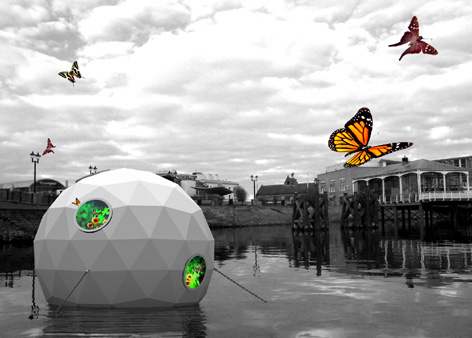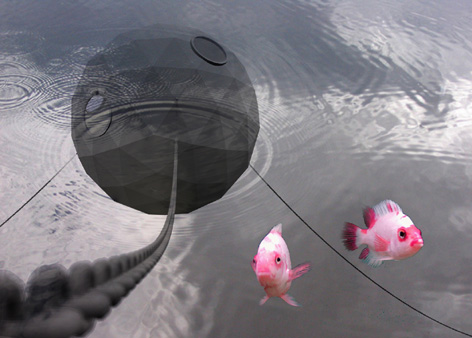MICROISLAND
 MICROISLAND interior computerized 3D model, 2008 |
|
|
Introduction:
MICROISLAND is an autonomous floating Island. It provides a peaceful habitat
for persons, animals and plants
MICROISLAND is a low cost geodesic structure using minimal amount of material
to create a maximum of enclosed space. MICROISLAND has got its own climate.
Sunshine, wind and rain are supplied inside the climate shell along with
an occasional rainbow. It generates energy using solar panels mounted
on the outside surface and stores it in a battery bank. The energy is
used to control the climate through an automatic system. A customized
starry sky and an artificial moon can be seen at night inside the structure.
The landscape inside MICROISLAND can be shaped in numerous ways according
to the surrounding climate and specific wishes of the persons building
it. It can easily be insulated if the temperature inside is preferred
to differ substantially from the outside. Dwelling quarters can be built
inside the climate shell using any technique from bamboo huts to brick
houses.
MICROISLAND is not planned to be an isolated biological system but is
dependent on a constant exchange with the surrounding world
MICROISLAND can be moored on lakes or rivers as well as at open sea. Sea
currents and kites can be used for moving the MICROIS-LAND or it can easily
be tugged
Groups of MICROISLANDS could form MICROISLAND communities.

Background:
:
Most of the surface of our planet is covered by water. Attractive land
territories are often overpopulated by humans to the extent that natural
habitats for animals and plants are disappearing rapidly. Vast areas are
used for food production based on monoculture farming and animals are
considered to be pests. Wars over territories are common in many areas
of the planet. Global warming will lead to flooding of areas where millions
live.
It is a realistic alternative to land based living, to begin colonizing
water areas and to find ways to live from the natural resources found
here in a sustainable way. Efficient windmills and solar panels could
already supply ecologically sound energy for living on the water in this
way
Using intensive farming technologies like hydroponics, vegetables and
fruit could be produced using small areas. Floating fish farms could supply
substantial amounts of fresh fish. The surface of the construction is
highly suitable for collecting freshwater. Compost toilets could help
recycling faeces as fertilizer
MICROISLAND could be one way of forming water based communities, living
on the waters of the planet
The MICROISLAND prototype will be a 5 meters in diameter version realized
in collaboration with Public Art Wales on behalf of Cardiff County Council´s
Harbour Authority. It will be situated within the Barrage estate. There
will be public access to MICROISLAND and it will be visible for bypassers
as well. Information about MICROISLAND will be dispensed at information
points along the pedestrian walkway.

Construction:
The main construction is made from 180 steel triangles, 4mm thick, welded
together. Its based on a 3 frequency version of the platonic shape Icosahedron.
Two sets of different triangles mounted together constitute an approximation
to a sphere to provide strength using a minimum of material to enclose
a maximum of space. The surface has been sandblasted and covered with
5 layers of epoxy paint for protection against corrosion
Submerged parts of the structure have been equipped with zinc anodes (sea
water conditions, magnesium for fresh water) to protect against galvanic
corrosion. Furthermore anti fouling paint has been applied. Three strong
points have been applied to the construction for mooring purposes. The
mooring consists of three Bruce Anchors and heavy chains to damp the movements
of the MICROISLAND in high wave conditions.
Doors and windows in the construction are placed in a window frame shaped
as steel tubes and are inserted into the structure to provide sufficient
strength and compensate for the weakening of the main structure that occurs
when the structure is penetrated. The transparent material is UV light-
protected polycarbonate
In order to create stability, a ballast of concrete is applied to the
MICROISLAND. In the centre of this sits a reservoir where condensed water
from the steel walls etc is collected and pumped out or used as water
for the inside lakes and rain for the climate features of the construction.
The soil applied to the island is mixed with a light weight material in
order to secure sufficient supply of oxygen to the plant roots. A system
of LED diodes forms a sun in daytime and stars and moon at night. Standard
greenhouse equipment (sprinklers, fans etc) is used to make rain and wind.
A battery bank is mounted in a space in the concrete along with a control
panel and computer for weather regulation. Parts of the outside of the
structure are covered in customized solar panels.
The MICROISLAND can easily be scaled up and down according to the specific
situation it is constructed for. Up to a point where each triangle can
no longer be handled by one person only, lifting equipment is not necessary.
This means that one person can build the MICROISLAND practically anywhere.
Because of the outstanding aerodynamics of MICROISLAND the wind resistance
is only about half of that of a similar orthogonal construction. This
has a positive impact both on the mooring technique and on insulation
issues

model

Extensions:
As mentioned above, food producing systems, water-collecting systems,
sewage handling systems etc could easily be applied. One could also imagine
specialized islands dedicated to energy production, food production and
so fort. Underwater wings to provide extra stability in rough waters could
also be applied
MICROISLAND can also be designed as a floating house, using all the space
inside for dwelling purposes only. This specific version of MICROISLAND
is called GEOSHELTER and will be described in detail in a later manual.
Government on MICROISLANDS:
Attention is directed to the logical relation between persons and the
rights of persons. Persons should be treated as persons and therefore
as having rights. If we deny this assertion it goes wrong: here is a person,
but this person should not be treated as a person, or: here is a person,
who should be treated as a person, but not as having rights. Therefore
we can only talk about persons in a way that makes sense if we know that
persons have rights
Health and safety issues:
Seaworthiness:
Depending on the size of the MICROISLAND, it can only support a specific
number of persons at a given time. A controlled capsizing test will be
performed, but calculations show that a 5 meter version of MICROISLAND
with a 10 tons ballast will allow a minimum of 10 persons to walk around
freely without any significant inclination of the island to occur. Capsizing
would require an absurd number of persons standing on top of each other.
Wind:
With the proper mooring MICROISLAND will be able to withstand a
Hurricane.
Leaks:
The MICROISLAND is equipped with a bilge pump and an alarm if a leak should
occur.
Lightening:
The construction function as a Faradays cage and will protect any visitors
from the effects of lightening
Man overboard situations:
Rescue equipment will be available at the entrance of MICROISLAND
Fire hazards:
The amount of flammable material inside the prototype will not lead to
a structural breakdown of the structure in case of fire. However, persons
inside the room would have to be evacuated in case of fire
Evacuation can take place through the door or one of the four windows.
Fire extinguishers will be available inside the structure
Maintenance:
Depending on the salinity of the waters and the electrical activity in
the MICROISLAND, the anodes will have to be changed from time to time.
This is a standard procedure for commercial divers. Alternatively the
MICROISLAND can be hauled to a shore, careened and the anodes changed.
This method can also be used for maintaining the epoxy paint. Experience
shows that a new layer should be applied every 10-20 years
The garden inside the prototype needs an occasional hand. If this is a
problem an artificial garden could be constructed.
However it will be possible to automate most of the systems by using standard
greenhouse equipment.
Safety equipment inside the prototype will have to be maintained and controlled
by the authorities.
Technical specifications for the 5 meter MICROISLAND:
Radius 2.5 meters:
Assembly diagram:

Basic module:
Steel type: 4mm standard plates DS EN 235 J2 G3, laser or plasma cut.
Diameter: 5 meter
Surface area of Dome: 76 m2
Enclosed space: 65 m3
Main steel construction weight: 2427 kg
Ballast weight 10000 kg ( will be adjusted according to waterline)
Ballast material: Concrete or stones (dredged pebbles placed in a cellular
structure), batteries and soil, some of it movable, for adjusting the
waterline
Inside area at waterline: 15 m2
Draught: 1.5 meter
Assembly: Welded by certified welder. Can be constructed on site or at
a ships wharf
Anti corrosion system: Sandblasting and Epoxy paint. Magnesium anodes,
5 kg distance between them: 2 meters
Mooring requirements:
At a maximum windload of 200 kg pr m2 one specific chain and anchor should
hold 2000 kg
Stability:For small angles:

Component list:
Triangle AAB: 60
Triangle BCC: 120
Window frames: 5
Windows: 4
Door: 1
Ladders made from steel tubes and welded onto the surface
Three strong points made from 10 mm steel plate welded to the construction
Steel chain
Three Bruce anchors
Solar panels
Batteries
Wiring
LED lights
Sprinklers
Bilge Pumps
Leak alarm
Fan
Weather computer
Light sensors
Soil
Lightweight material used to cultivate soil
Plants
Animals
Fire extinguishers
Life jackets

By N55/ Ion Sørvin and Øjvind Alexander Slaatto.
Team:
Technical assistance: 3D modeling, Peter Balch Berthelsen, Designer
Advice on welding techniques: Peter Madsen
Stability calculations: Christian Ravn, Engineer.
By N55, Ion Sørvin, Øivind Alexander Slaatto
Thanks to I
Dedicated to Ingvil Hareide Aarbakke, Co-founder of N55
WALKING HOUSE has been realized with support from: